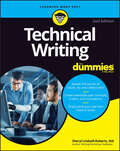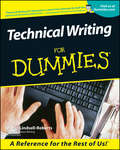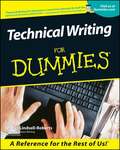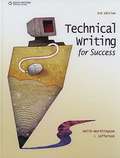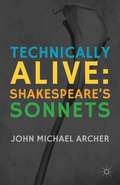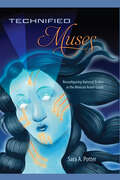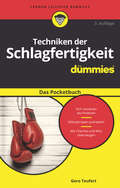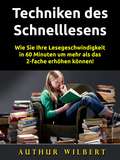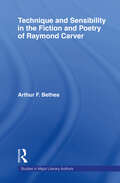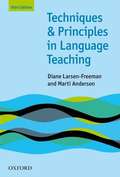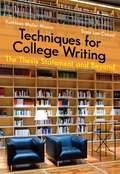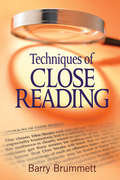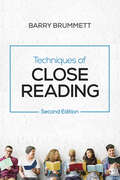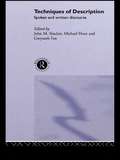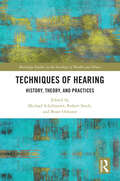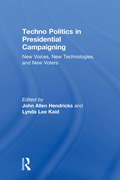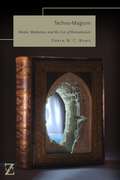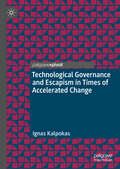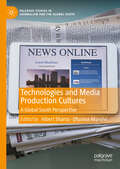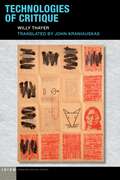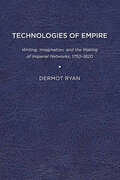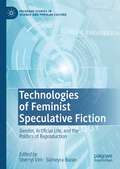- Table View
- List View
Technical Ekphrasis in Greek and Roman Science and Literature
by Courtney RobyEkphrasis is familiar as a rhetorical tool for inducing enargeia, the vivid sense that a reader or listener is actually in the presence of the objects described. This book focuses on the ekphrastic techniques used in ancient Greek and Roman literature to describe technological artifacts. Since the literary discourse on technology extended beyond technical texts, this book explores 'technical ekphrasis' in a wide range of genres, including history, poetry, and philosophy as well as mechanical, scientific, and mathematical works. Technical authors like Philo of Byzantium, Vitruvius, Hero of Alexandria, and Claudius Ptolemy are put into dialogue with close contemporaries in other genres, like Diodorus Siculus, Cicero, Ovid, and Aelius Theon. The treatment of 'technical ekphrasis' here covers the techniques of description, the interaction of verbal and visual elements, the role of instructions, and the balance between describing the artifact's material qualities and the other bodies of knowledge it evokes.
Technical Report Writing Today
by Daniel RiordanTECHNICAL REPORT WRITING TODAY provides thorough coverage of technical writing basics, techniques, and applications. Through a practical focus with varied examples and exercises, students internalize the skills necessary to produce clear and effective documents and reports. Project worksheets help students organize their thoughts and prepare for assignments, and Focus boxes highlight key information and recent developments in technical communication. Extensive individual and collaborative exercises expose students to different kinds of technical writing problems and solutions. Annotated student examples--more than 100 in all--illustrate different writing styles and approaches to problems. Numerous short and long examples throughout the text demonstrate solutions for handling writing assignments in current career situations. The four-color artwork in the chapter on creating visuals keeps pace with contemporary workplace capabilities. The Tenth Edition offers the latest information on using electronic resumes and documenting electronic sources and Ethics and Globalization sidebars that highlight these two important topics in the technical communication field.
Technical Writing For Dummies
by Sheryl Lindsell-RobertsLearn to document the technology that makes the world go Technical Writing For Dummies is a master class on how to build a career writing user manuals, e-learning, streaming, simulations, and more. It even zooms into the metaverse. Whether you’re new to the field, a seasoned professional, or a technical person who needs to write, this guide arms you with the skills you need to cash in on this flourishing world of technical writing. This isn’t your average how-to. It’s a compendium of innovative industry knowledge that will help you set yourself apart with the latest trends and best practices in technical writing. As a tech writer, you’ll need a robust skillset that allows you to offer clear and concise documentation for just about anything. This new edition of Technical Writing For Dummies—updated for all of today’s tech writing advances—can get you there. Uncover the basics of technical writing and master common documentation types Get insight into the career paths available to tech writers today Discover new remote collaboration options and cloud-based tools for technical writers Learn how to elevate your documents for high search engine optimization (SEO) rankings Improve your craft to connect with diverse, global audiencesWhether you’re a technical writer or technical professional who needs to write—you can learn the best practices of effective technical writing, as well as how to navigate its various formats and platforms, thanks to this handy Dummies guide.
Technical Writing For Dummies (For Dummies Ser.)
by Sheryl Lindsell-RobertsLet’s face it, a lot of technical documentation reads as if it had been translated into English from Venutian by a native speaker of gibberish. Which is annoying for you and expensive for the manufacturer who pays with alienated customers and soaring technical support costs. That’s why good technical writers are in such big demand worldwide. Now, Technical Writing For Dummies arms you with the skills you need to cash in on that demand. Whether you’re contemplating a career as a technical writer, or you just got tapped for a technical writing project, this friendly guide is your ticket to getting your tech writing skills up to snuff. It shows you step-by-step how to: Research and organize information for your documents Plan your project in a technical brief Fine-tune and polish your writing Work collaboratively with your reviewers Create great user manuals, awesome abstracts, and more Write first-rate electronic documentation Write computer- and Web-based training courses Discover how to write energized technical documents that have the impact you want on your readers. Wordsmith Sheryl Lindsell-Roberts covers all the bases, including: All about the red-hot market for technical writing and how to get work as a technical writer The ABCs of creating a strong technical document, including preparing a production schedule, brainstorming, outlining, drafting, editing, rewriting, testing, presentation, and more Types of technical documents, including user manuals, abstracts, spec sheets, evaluation forms and questionnaires, executive summaries, and presentations Writing for the Internet—covers doing research online, creating multimedia documents, developing computer-based training and Web-based training, and writing online help Combining examples, practical advice, and priceless insider tips on how to write whiz-bang technical documents, Technical Writing For Dummies is an indispensable resource for newcomers to technical writing and pros looking for new ideas to advance their careers.
Technical Writing for Dummies (For Dummies Series)
by Sheryl Lindsell-RobertsLet’s face it, a lot of technical documentation reads as if it had been translated into English from Venutian by a native speaker of gibberish. Which is annoying for you and expensive for the manufacturer who pays with alienated customers and soaring technical support costs. That’s why good technical writers are in such big demand worldwide. Now, Technical Writing For Dummies arms you with the skills you need to cash in on that demand. Whether you’re contemplating a career as a technical writer, or you just got tapped for a technical writing project,this friendly guide is your ticket to getting your tech writing skills up to snuff. It shows you step-by-step how to: <ul> <li>Research and organize information for your documents</li> <li>Plan your project in a technical brief</li> <li>Fine-tune and polish your writing</li> <li>Work collaboratively with your reviewers</li> <li>Create great user manuals, awesome abstracts, and more</li> <li>Write first-rate electronic documentation</li> <li>Write computer- and Web-based training courses</li> </ul> <P><P> Discover how to write energized technical documents that have the impact you want on your readers. Wordsmith Sheryl Lindsell-Roberts covers all the bases, including: <ul> <li>All about the red-hot market for technical writing and how to get work as a technical writer</li> <li>The ABCs of creating a strong technical document, including preparing a production schedule, brainstorming, outlining,drafting, editing, rewriting, testing, presentation, and more</li> <li>Types of technical documents, including user manuals,abstracts, spec sheets, evaluation forms and questionnaires,executive summaries, and presentations</li> </ul> <P><P>Writing for the Internet—covers doing research online,creating multimedia documents, developing computer-based training and Web-based training, and writing online help Combining examples, practical advice, and priceless insider tips on how to write whiz-bang technical documents, Technical Writing For Dummies is an indispensable resource for newcomers to technical writing and pros looking for new ideas to advance their careers.
Technical Writing for Success
by Darlene Smith-Worthington Sue JeffersonTaking an applied approach to teaching workplace writing, TECHNICAL WRITING FOR SUCCESS 3E is a comprehensive text designed to focus on skills that employers demand in today's workplace--thinking, listening, composing, revising, and editing. Students are encouraged to acquire many workplace skills through integrated and applied instruction so that mastering technical writing is relevant and exciting. Abundant model documents reflect Office 2007 formats and include questions providing critical thinking opportunities. This comprehensive text features an engaging writing style, student and real-world models, write-to-learn activities, expanded oral presentation coverage, and much more. TECHNICAL WRITING FOR SUCCESS 3E provides instruction on the less common documents not covered in general communication texts, e. g. , proposals, news releases, science lab reports, and instructions. Chapter contents include technical research; writing for the Web; brief informative, brief investigative and recommendation reports; as well as technical reading.
Technically Alive
by John Michael ArcherDrawing on the later writings of Martin Heidegger, the book traces the correspondence between the philosopher's concept of technology and Shakespeare's poetics of human and natural productivity in the Sonnets.
Technified Muses: Reconfiguring National Bodies in the Mexican Avant-Garde
by Sara A. PotterExamining representations of the female body in postrevolutionary genre literature In this volume, Sara Potter uses the idea of the muse from Greek mythology and the cyborg from posthuman theory to consider the portrayal of female characters and their bodies in Mexican art and literature from the 1920s to the present. Examining genres including science fiction, cyberpunk, and popular fiction, Potter finds that “technified muse” figures often appear in these texts at moments of violence and sociopolitical transformation. Potter begins by looking at two avant-garde movements that emerged in the aftermath of the Mexican Revolution: the Estridentistas and the Contemporáneos. Moving to the “Mexican Miracle,” a midcentury period of economic prosperity, she considers the work of surrealists Leonora Carrington and Remedios Varo within their cultural and political climates. She then addresses the aftermath of the 1968 student massacre in Tlatelolco as explored in Fernando del Paso’s Palinuro de México and Juan García Ponce’s Crónica de la intervención. Finally, Potter engages with the era that began with the 1994 North American Free Trade Agreement and Zapatista rebellion, drawing from Bernardo Fernández’s Gel azul, Guadalupe Nettel’s El huésped, and Karen Chacek’s La caída de los pájaros. Technified Muses shows that during these key periods, writers created muse-like characters that interact with the technological discourses of their times. These figures reflect the increasing emphasis on science and progress throughout the twentieth century, embodying the modernization of Mexico while offering parallel narratives that challenge official portrayals of the nation’s history. Publication of this work made possible by a Sustaining the Humanities through the American Rescue Plan grant from the National Endowment for the Humanities.
Techniken der Schlagfertigkeit für Dummies Das Pocketbuch (Für Dummies)
by Gero TeufertFühlen Sie sich manchmal sprachlos bei Vorwürfen, kritischen Fragen, Killerphrasen oder verbalen Tiefschlägen im Beruf oder Privatleben? "Techniken der Schlagfertigkeit für Dummies" hilft Ihnen, auf verbale Attacken witzig, wortgewandt und rhetorisch überlegen zu reagieren und selbst dann noch angemessen zu kontern, wenn der Gesprächspartner unter die Gürtellinie zielt. Gezielte Techniken ermöglichen es Ihnen, Ihre Konter- und Assoziationsfähigkeit schrittweise zu stärken. So können Sie mit Standardsätzen selbst in Stresssituationen schlagfertige Antworten aus dem Ärmel schütteln. Lernen Sie souverän zu reagieren und dabei Humor ins Spiel zu bringen. Überwinden Sie Ihre Sprachlosigkeit, zücken Sie den verbalen Degen und schlagen Sie zurück!
Techniken des Schnelllesens: Wie Sie Ihre Lesegeschwindigkeit in 60 Minuten um mehr als das 2-fache erhöhen können!
by Arthur WilbertTechniken des Schnelllesens: Wie Sie Ihre Lesegeschwindigkeit in 60 Minuten um mehr als das 2-fache erhöhen können! von Arthur Wilbert Eine Einführung in die Geheimnisse, mit denen Profis schneller als jeder andere lesen können! Möchten Sie Ihre Arbeit und Ihre E-Mails zweimal schneller als bisher erledigen können? Denken Sie nur an die Zeit, die Sie sparen würden... Eine Einführung in die Geheimnisse, mit denen Profis schneller als jeder andere lesen können! Mit jahrzehntelang erprobten Strategien zeigt Ihnen dieses eBook den schnellsten und effektivsten Weg, Ihre Lesegeschwindigkeit in nur wenigen Stunden um bis zur zweifachen Geschwindigkeit zu erhöhen! Sie werden lernen, wie Sie Ihre Geschwindigkeit in nur wenigen Stunden erhöhen können. Nicht nur das: Sie werden auch in der Lage sein, Ihre Produktivität zu steigern und Zeit zu gewinnen, die Sie sonst für E-Mails, Hausaufgaben, Lernen, Bücher, das Lesen von Nachrichtenartikeln und praktisch alles andere aufgewendet hätten. Möchten Sie wissen, wie Personen mit langsamen Leseverständnis ihre Lesegeschwindigkeit erhöht haben? Auch Sie können die Geheimnisse erfahren, die Ihnen erlauben, effizienter zu arbeiten und gleichzeitig Zeit zu gewinnen. Dieser Leitfaden vermittelt Ihnen bewährte Techniken ohne teure Ergänzungen oder Kurse. Was Sie bekommen: - Erhöhen Sie Ihre Lesegeschwindigkeit um mehr als die doppelte Geschwindigkeit! - Techniken, die das Lesen einfacher und schneller machen. - Blättern Sie mit einem Blick durch die Absätze! - Einfache, leichte Schritte. - Lernen Sie schneller zu lesen in 1 Stunde oder weniger! + VIEL MEHR! Wenn Sie Ihre Lesegeschwindigkeit auf die bestmögliche Art und Weise erhöhen wollen, dann ist dieses Buch genau das Richtige für Sie. --> Scrollen Sie zum Anfang der Seite und klicken Sie auf "In den Warenkorb",
Technique and Sensibility in the Fiction and Poetry of Raymond Carver (Studies in Major Literary Authors #7)
by Arthur F. BetheaA comprehensive examination of the fiction and poetry of Raymond Carver.
Techniques and Principles in Language Teaching
by Diane Larsen-Freeman Marti AndersonTechniques and Principles in Language Teaching helps you to learn about many different language teaching methods, to uncover the thoughts that guide your own actions as a teacher, and introduces you to a variety of techniques. The third edition includes chapters on: The Grammar-Translation Method The Direct Method The Audio-Lingual Method The Silent Way DesuggestopediaCommunity Language Learning Total Physical Response Communicative Language Teaching Content-based Instruction Task-based Language Teaching The Political Dimensions of Language Teaching and the Participatory Approach Learning Strategy Training,Cooperative Learning, and Multiple Intelligences Emerging Uses of Technology in Language Teaching and Learning View Diane Larsen-Freeman explaining the need to consider a range of methods in language teaching, and how methods continue to evolve. View Marti Anderson explaining the importance of reflecting on methodology. Links to videos on website
Techniques for College Writing: The Thesis Statement and Beyond
by Kathleen Muller Moore Susie Lan CasselThis book is divided into three parts that build on one another. Part One (Thinking Through the Thesis Statement) introduces the basics for writing a paper--from think¬ing about the audience and format to developing a thesis statement and concluding well. Part Two (Thinking Through Your Writing Assignment) moves to the next stage of the writing process by looking more closely at the writing prompt and its requirements to plan a response that is relevant and appropriate. Part Three (Writing Beyond the Composition Classroom) looks beyond the composition classroom to more specialized writing, such as writing for a scientific paper, an informa¬tive paper, and literature reviews.
Techniques of Close Reading
by Barry S. BrummettIn a world in which messages increasingly ask us to believe, accept, buy, and follow, the ability to read texts closely in order to gain a deeper understanding of their meanings is an indispensable survival skill. Techniques of Close Reading is a brief book that helps students see what texts may be saying, be they written, oral, visual, or mediated. Renowned scholar and professor Barry Brummett explains and explores the various ways to "read" messages (such as speeches, cartoons, or magazine ads), teaching students how to see deeper levels of meaning and to share those insights with others. Students learn techniques for discovering form, rhetorical tropes, argument, and ideologies within texts.This book differs from other books in rhetorical criticism, textual analysis, or critical thinking by: Focusing on the act and techniques of criticism rather than on schools of thought, grand theories, and specific methods, thus helping students to engage in the act of critical close reading in ways that are congenial to a wide range of methods - making the book an ideal companion to texts focused on specific methodsExplaining the relationships among theory, methods, and techniques of rhetorical criticismExamining the ethics and risks of doing and reading rhetorical criticism via plenty of examples, figures, and exercises taken from everyday life Serving as a brief, affordable text, thus allowing instructors the flexibility to assign other textbooks
Techniques of Close Reading
by Barry S. BrummettTechniques of Close Reading, Second Edition helps students gain a deeper understanding of what texts may be saying, whether they are written, oral, visual, or mediated. Renowned scholar and professor Barry Brummett explains and explores the various ways to "read" messages (such as speeches, cartoons, or magazine ads), teaching students how to see deeper levels of meaning and to share those insights with others. Students learn techniques for discovering form, rhetorical tropes, argument, and ideologies within texts. New to the Second Edition: A new Chapter 6 includes a selection of techniques from each chapter to show students how different techniques may be used together when reading text. A close reading of a group of ads from the insurance company, Liberty Mutual, offers students an opportunity to apply the techniques to recent texts.
Techniques of Close Reading
by Barry S. BrummettTechniques of Close Reading, Second Edition helps students gain a deeper understanding of what texts may be saying, whether they are written, oral, visual, or mediated. Renowned scholar and professor Barry Brummett explains and explores the various ways to "read" messages (such as speeches, cartoons, or magazine ads), teaching students how to see deeper levels of meaning and to share those insights with others. Students learn techniques for discovering form, rhetorical tropes, argument, and ideologies within texts. New to the Second Edition: A new Chapter 6 includes a selection of techniques from each chapter to show students how different techniques may be used together when reading text. A close reading of a group of ads from the insurance company, Liberty Mutual, offers students an opportunity to apply the techniques to recent texts.
Techniques of Description: Spoken and Written Discourse
by Michael Hoey Gwyneth Fox John M. SinclairThis book is a tribute to Malcolm Coulthard, who has been remarkably active and influential across a wide range of English Language Studies. He is particularly well-known for his pioneering work in spoken and written discourse analysis and most recently, for his work in forensic linguistics. This collection of specially commissioned, state-of-the-art pieces by leading international linguists is dedicated to the man and his achievements and provides a showcase for the most exciting developments in applied discourse studies. All the papers share common assumptions about language study: that descriptions should be data-based, data-tested and replicable. The collection as a whole contains original and important new research on descriptions, with intriuging applications to forensic, gender and literary studies.
Techniques of Hearing: History, Theory and Practices
by Michael Schillmeier, Robert Stock, and Beate OchsnerHearing, health and technologies are entangled in multi-faceted ways. The edited volume addresses this complex relationship by arguing that modern hearing was and is increasingly linked to and mediated by technological innovations. By providing a set of original interdisciplinary investigations that sheds new light on the history, theory and practices of hearing techniques, it is able to explore the heterogeneous entanglements of sound, hearing practices, technologies and health issues. As the first book to bring together historians, scholars from media studies, social sciences, cultural studies, acoustics and neuroscientists, the volume discusses modern technologies and their decisive impact on how ‘normal’ hearing, enhanced and smart hearing as well as hearing impairment have been configured. It brings both new insights into the histories of hearing technologies as well as allowing us to better understand how enabling hearing technologies have currently been unfolding an increasingly hybrid ecology engaging smart hearing devices and offering stress-free hearing and acoustic wellbeing in novel auditory environments. The volume will be of interest to all scholars and students of disability studies, sound studies, sociology of health and illness, medical history, health and society as well as those interested in the practices and techniques of self-monitored and smart hearing.
Techno Politics in Presidential Campaigning: New Voices, New Technologies, and New Voters
by John Allen Hendricks Lynda Lee KaidThe 2008 US presidential campaign saw politicians utilizing all types of new media -- Facebook, MySpace, YouTube, Twitter, e-mail, and cell phone texting – to reach voters of all ages, ethnicities, socio-economic backgrounds, and sexual orientations. This volume examines the use of these media and considers the effectiveness of reaching voters through these channels. It explores not only the use of new media and technologies but also the role these tactics played in attracting new voters and communicating with the electorate during the 2008 presidential debates. Chapters focus on how the technologies were used by candidates, the press, and voters.
Techno-Magism: Media, Mediation, and the Cut of Romanticism (Lit Z)
by Orrin N. WangShortlisted, Marilyn Gaull Book AwardTechno-Magism explores how British Romantic literature abuts and is organized around both print and non-print media. The book explores not only the print, pictorial art, and theater of early nineteenth-century England and Europe but also communicative technologies invented after the British Romantic period, such as photography, film, video, and digital screens. This proleptic abutting points to one way we can understand the implicit exceptionality wagered by reading Romanticism through media studies and media theory.Techno-Magism argues that both media studies and the concept of mediation in general can benefit from a more robust confrontation with, or recovery of, the arguments of deconstruction, an unavoidable consequence of thinking about the relationship between Romanticism and media. The book thinks that relationship through the catachrestic practice of a techno-magism, a technics of inscription always outside the causalities of a dialectical economy. The book further pursues two interrelated ideas: the structural incommensurability of the cut and the unapologetic presentism of the constellation. Marked by its late capitalist moment of composition, the book explores the continuity between the social character of Romantic and post-Romantic media, in terms of commodity culture, revolution, and the ecological devastation of the anthropocene.
Technological Governance and Escapism in Times of Accelerated Change (Information Technology and Global Governance)
by Ignas KalpokasThis book examines escapist coping strategies brought about by the pace, breadth and governance of technological change. It argues that escapism manifests in various forms, ranging from nostalgia for a fantasised past of unhindered reason and agency, to progressive visions of societal and political improvement, and greater empowerment. Drawing on post-humanist theory and critical disability studies, the book also assesses how escapism should not be viewed as an unavoidable reaction to technological change, and develops a model for an ethically equitable relationship between humans and technology. It will appeal to all those interested in governance and politics, media and communication studies, technology studies, and philosophy.
Technologies and Media Production Cultures: A Global South Perspective (Palgrave Studies in Journalism and the Global South)
by Ufuoma Akpojivi Albert SharraThis volume delves into the intricate relationship between technology and media production, emphasizing its influence across political, socio-economic, and cultural contexts. By 2010, the integration of computing and automated systems had already begun revolutionizing media production, prompting traditional outlets to embrace a 'digital first' approach. Concepts like dual-management processes and the fusion of traditional and digital systems have emerged, challenging conventional norms. What sets this transformation apart is the gradual replacement of human decision-making with communicative artificial intelligence and automation. Technology now plays a central role in producing and distributing news and Ads, fundamentally altering the media landscape. However, there has been limited exploration of the broader implications of these advancements, particularly from the perspective of the Global South. This edited volume seeks to address this gap by featuring papers that examine how technology has reshaped newsroom and advertorial processes in countries like Malawi, South Africa, and Nigeria. Through a collection of insightful essays, readers are invited to explore the transformative power of technology in media production, packaging, and distribution systems. From digital innovations to traditional media adaptations, this volume offers a comprehensive understanding of the evolving media landscape in the age of technology.
Technologies of Critique (Idiom: Inventing Writing Theory)
by Willy ThayerCritique—a program of thought as well as a disposition toward the world—is a crucial resource for politics and thought today, yet it is again and again instrumentalized by institutional frames and captured by market logics. Technologies of Critique elaborates a critical practice that eludes such capture. Building on Chile’s history of dissident artists and the central entangling of politics and aesthetics, Thayer engages continental philosophical traditions, from Aristotle, Descartes and Heidegger through Walter Benjamin and Gilles Deleuze, and in implicit conversation with the Judith Butler, Roberto Esposito, and Bruno Latour, to help pinpoint the technologies and media through which art intervenes critically in socio-political life.
Technologies of Empire: Writing, Imagination, and the Making of Imperial Networks, 1750–1820
by Dermot RyanTechnologies of Empire looks at the ways in which writers of the long eighteenth century treat writing and imagination as technologies that can produce rather than merely portray empire. Authors ranging from Adam Smith to William Wordsworth consider writing not as part of a larger logic of orientalism that represents non-European subjects and spaces in fixed ways, but as a dynamic technology that organizes these subjects and transforms these spaces. Technologies of Empire reads the imagination as an instrument that works in tandem with writing, expanding and consolidating the networks of empire. Through readings across a variety of genres, ranging from Smith’s The Wealth of Nations and Edmund Burke’s Reflections on the Revolution in France to Maria Edgeworth’s Irish fiction and Wordsworth’s epic poetry, this study offers a new account of writing’s role in empire-building and uncovers a genealogy of the romantic imagination that is shot through by the imperatives of imperialism. Published by University of Delaware Press. Distributed worldwide by Rutgers University Press.
Technologies of Feminist Speculative Fiction: Gender, Artificial Life, and the Politics of Reproduction (Palgrave Studies in Science and Popular Culture)
by Sherryl Vint Sümeyra BuranTechnologies of Feminist Speculative Fiction: Gender, Artificial Life, and the Politics of Reproduction explores how much technology has reshaped feminist conversations in the decades since Donna Haraway’s influential “Cyborg Manifesto” was published. With sections exploring reproductive technologies, new ways of imagining femininity and motherhood via artificial means, queer readings of gender as a social technology, and posthuman visions of a world beyond gender, this book demonstrates how feminist speculative fiction offers an urgently needed response to the intersections of women’s bodies and technology. This collection brings together authors from Europe, Japan, the US and the UK to consider speculative films and texts, reproductive technologies and food futures, and opportunities to rethink family, aging, gender and sexuality, and community through feminist speculative fiction, a social technology for building better futures.

